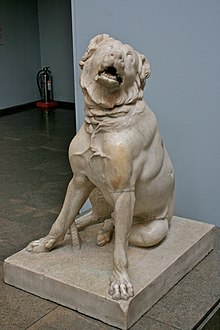Molossian hound
| Molossus | |
|---|---|
 The "Jennings Dog", a Roman copy of a lost Greek bronze statue, on display in the British Museum. | |
| Other names |
|
| Origin | Epirus, ancient Greece |
| Breed status | Extinct |
| Dog (domestic dog) | |
The Molossus (Greek: Μολοσσός, romanized: Molossós), also known as the Molossian hound and Epirus mastiff, is an extinct dog breed from Ancient Greece.
History[edit]
The Molossus were dogs that were kept by the ancient Greek tribe and kingdom of the Molossians, who inhabited the region of Epirus.[1][2]
The Molossus were famous throughout the ancient world for their size and ferocity and were frequently mentioned in ancient literature, including the writings of Aristophanes,[3] Aristotle,[4] Grattius,[5] Horace,[6][7] Lucan,[8] Lucretius,[9] Martial,[10] Nemesianus,[11] Oppian of Apamea,[12] Plautus,[13] Seneca,[14] Statius,[15][16][17] Ovid,[18] and Virgil.[19] The Molossians issued silver coinage with an image of a Molossus as their emblem.[1]
It is sometimes stated in books and magazines, particularly in Continental Europe and North America, that all mastiff-type dogs are descended from the Molossus.[1][2] This theory states that the breed's progenitors arrived in Molossia from Asia and were eventually discovered by the Romans who employed large numbers as guards for the Roman Army; this theory speculates that the various mastiff breeds found throughout Europe descend from dogs left behind by the Romans.[2] This theory has been questioned by many experts who state it relies on guesswork and lacks historical evidence, and that mastiffs likely developed elsewhere.[1][2]
Another story is that in the course of his military conquests Alexander the Great discovered some giant dogs in Asia that impressed him so much that he sent some home; as the son of a Molossi princess these dogs became associated with his mother's people and that it was from these dogs that all mastiffs descend.[2]
It seems most likely that Molossi kept two distinct types of dogs, one a hunting dog with a broad muzzle which resembled something in between a Great Dane and a heavily built Saluki, the other a large livestock guardian dog.[1][2] Aristotle in his History of Animals wrote "In the Molossian race of dogs, those employed in hunting differ in no respect from other dogs; while those employed in following sheep are larger and more fierce in their attack on wild beasts."[1][4] He also added that dogs that are born of a mixed breed between the Molossian and the Laconian dogs are remarkable for courage and endurance of hard labour.[4]
Polycrates of Samos imported Molossian and Laconian dogs to the island.[20]
According to Greek mythology the goddess Artemis gave to Procris a dog, Laelaps, that never failed to catch its prey and from this dog derived the Molossian and Laconian hounds.[21]
Modern kennel club classification[edit]
A number of modern kennel clubs, including the Fédération Cynologique Internationale, group the distinct mastiffs with livestock guardian dogs as a single type they call "molossoid".[1][22][23] It has been theorised that this confusion is due to mistranslations of ancient texts and assumptions based solely on size.[1][22]
See also[edit]
References[edit]
- ^ a b c d e f g h Hancock, David (2001). The mastiffs: the big game hunters, their history, development & future. Ducklington, Oxon: Charwynne Dog Features. ISBN 9780951780114.
- ^ a b c d e f Morris, Desmond (2001). Dogs: the ultimate dictionary of over 1,000 dog breeds. North Pomfret, VT: Trafalgar Square Publishing. pp. 616–617 & 703. ISBN 1-57076-219-8.
- ^ Aristophanes, Thesmophoriazusae, 416.
- ^ a b c Aristotle, History of Animals, IX. I. 2. Translated by Richard Cresswell, London: George Bell & Sons, 1887.
- ^ Grattius, Cynegeticon, 169.
- ^ Horace, Epodes,VI.
- ^ Horace, Satires 2, VI. 114.
- ^ Lucan, Pharsalia, IV. 440.
- ^ Lucretius, De rerum natura, V. 1063.
- ^ Martial, Epigram, XII. I. 1.
- ^ Nemesianus, Cynegetica, 107.
- ^ Oppian, Cynegetica, I. 375.
- ^ Plautus, Captivi, 86.
- ^ Seneca, Phaedra, 33.
- ^ Statius, Achilleid, I. 747.
- ^ Statius, Silvae, II. VI. 19.
- ^ Statius, Thebaid, III. 203.
- ^ Ovid, Metamorphoses, I. 226.
- ^ Virgil, Georgics, III. 405.
- ^ Athenaeus, Deipnosophists, 12.57
- ^ Peck, Harry Thurston (1898). Harpers dictionary of classical antiquities. New York: Harper and Brothers. Retrieved 23 July 2021.
- ^ a b Ash, Edward Cecil (1927). Dogs: their history and development. London: Ernest Benn. p. 499.
- ^ "Group 2: Pinscher and Schnauzer - Molossoid and Swiss Mountain and Cattledogs". Fédération Cynologique Internationale. Retrieved 27 January 2021.
